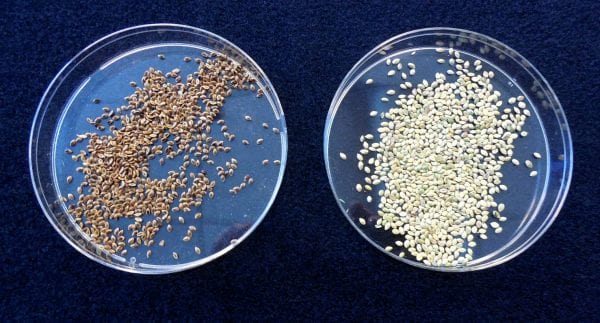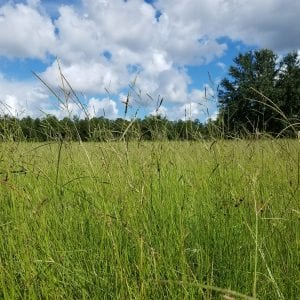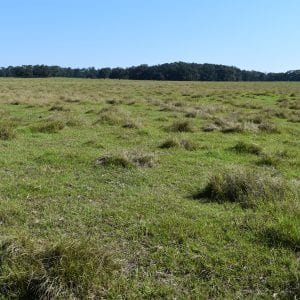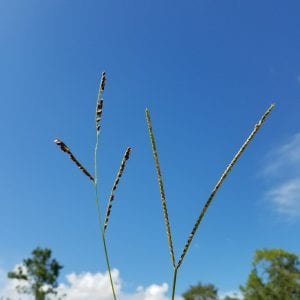Forages

Brunswickgrass (Paspalum nicorae Parodi) is becoming a problematic weed in summer perennial grass pastures in the Southeast.
Introduction
This plant is native to southern Brazil, northern Argentina, Paraguay, and Uruguay. It was introduced in the United States as a soil conservation plant for erosion control and as a potential forage crop. Brunswickgrass is well adapted to moderately acidic, sandy soils, but it also grows well in sandy loam and well-drained, light to medium clay-based soils. The plant is competitive with bahiagrass and bermudagrass. Because it is less palatable, it can eventually dominate a perennial grass pasture. Brunswickgrass has become naturalized and has reportedly contaminated bahiagrass seed fields and pastures in southeastern states, including in multiple Alabama counties.
Cattle will consume brunswickgrass when it is young and tender. The plant, however, quickly becomes rank and loses its palatability, and cattle avoid it. It proliferates when the more desirable forages have been overgrazed. As it thrives under reduced competition, it spreads and becomes more difficult to eradicate. Pastures contaminated with this grass will appear to have tufts or hills of plants where cattle refuse to graze (figure 1). Because of the rhizomatous habit of the plant, those patches tend to increase in size year after year and eventually dominate the pasture.
During the seed cleaning process, brunswickgrass seed does not readily separate from Pensacola bahiagrass seed. Both seeds are close in size and shape. This has made it difficult for bahiagrass seed processors to effectively eliminate brunswickgrass in order to meet total weed seed specifications (2.0 percent) for saleable seed. It is believed that brunswickgrass is more readily removed from Argentine bahiagrass due to differences in seed size. An increasing number of reports indicate brunswickgrass infestations in pastures around the state, and certain measurements should be taken to reduce spread. The most effective way is to avoid infestation by using certified seeds when establishing new pastures. No herbicide management is currently recommended. However, in cases of high infestation, total systemic herbicide application followed by cultivation and crop rotation could be needed.
- Figure 1. Closely grazed bahiagrass pasture with patches of brunswickgrass in late September (toward end of growing season) in Levy County, Florida.
- Figure 2. Bahiagrass seed field contaminated by brunswickgrass. Species are similar, but can be differentiated by seed head.
- Figure 3. Seed heads of brunswickgrass (left) and bahiagrass (right).
Appearance

Figure 4. Rhizome comparison of Pensacola bahiagrass (left) and brunswickgrass (right).
Brunswickgrass is a perennial summer grass with a growing season and appearance similar to those of bahiagrass (figure 2), especially during the vegetative phase. Brunswickgrass often has three to four racemes per seed head (figure 3, left), while Pensacola bahiagrass (P. notatum var. saurae Parodi) typically has two to three racemes (figure 3, right). Brunswickgrass has a deep and aggressive rhizome system that looks different from bahiagrass rhizomes. Brunswickgrass rhizomes occur below the soil surface (with a depth of approximately 4 in or 10 centimeters) and spread laterally (figure 4, left), while bahiagrass rhizomes, which are sometimes referred to as stolons, spread along the soil surface (figure 4, right).
Seeds are slightly smaller than those of Pensacola bahiagrass. The seed coat has a dark, chestnut brown center that varies somewhat in size, depending on the variety. The seeds are noticeably convex in shape compared to the relatively flat, tan seeds of Pensacola bahiagrass (figures 5 and 6). Seed may average about 200,000 per pound, based on our estimates.

Figure 5. Seeds of brunswickgrass (left) and Pensacola bahiagrass (right).

Figure 6. Close-up of brunswickgrass (A, left) and Pensacola bahiagrass (B right) seeds. Note the brown-colored coat of the brunswickgrass seeds when removing the glumes (arrow on A).
Table 1. Comparison of Brunswickgrass and Pensacola Bahiagrass
| Characteristic | Brunswickgrass | Pensacola Bahiagrass |
|---|---|---|
| Growing season | April to October | April to October |
| Flowering | July to September | July to September |
| Height | 8 to 28 inches | 4 to 24 inches |
| Leaf shape | Linear, lanceolate, white mid-rib | Linear, laceolate, crowded at the base with overlapped keeled sheaths |
| Leaf size | 8-14 in long, 0.25 in wide, but highly variable | 1-20 in long, 0.1-0.5 in wide |
| Leaf pubescence | Generally smooth, but can be hairy | Smooth leaves and sheath |
| Seed head | 3 to 4 alternate racemes | 2 racemes, Y-shaped |
| Seeds | Brown-coated, convex, hairy glumes when present | Tan-colored, relatively flat |
| Seed weight | Estimated 200,000 seeds/lb | Estimated 250,000 to 275,000 seeds/lb |
| Root system | Long, thin rhizomes | Short, thick J-shaped superficial rhizomes |
Management
Brunswickgrass is tetraploid, similar to Argentine-type bahiagrass. Control of this grass with herbicides will likely be more difficult because of its higher ploidy level. No herbicides currently exist that will selectively remove brunswickgrass without severely injuring or killing the desirable pasture grass. Several recent herbicide treatments on brunswickgrass-infested Florida pastures do show some promise of possible chemical control. However, these are preliminary results that require further confirmation of successful eradication or reduced brunswickgrass stands. Systemic herbicides should be the most effective in killing brunswickgrass, due to the plant’s strong rhizome system. High rates of glyphosate will likely be required to kill the pasture as the first step of total field renovation. Mechanical cultivation alone may not solve the problem; it may exacerbate the spread of brunswickgrass through rhizome segments. A combination of mechanical cultivation, herbicides, and crop rotation may provide successful control of brunswickgrass, because seed survival in the soil seed bank is not believed to be long-term.
The best preventive actions a producer can take to avoid further distribution of this grass are to refrain from harvesting contaminated production fields and to always use certified seeds when establishing new pastures. Certified (“blue tag”) seed has been produced under strict production guidelines that minimize the risk of weed contamination. Large quantities of bahiagrass seed are sold without any field inspections for purity, resulting in the sale of some contaminated seed for use in new pasture plantings. Purchase certified seed from a reliable seed source.
Leanne Dillard, Extension Specialist, Assistant Professor, Animal Sciences and Forages, Auburn University; Ann Blount, University of Florida; Marcelo Wallau, University of Florida; Brent Sellers, University of Florida; Dennis Hancock, University of Georgia; Jose Dubeaux, University of Florida; Cheryl Mackowiak, University of Florida; Joao Vendramini, University of Florida; and Clay Cooper, University of Florida
Reviewed April 2022, Brunswickgrass: A Weed in Southern Pastures & Bahiagrass Seed Fields, ANR-2537




